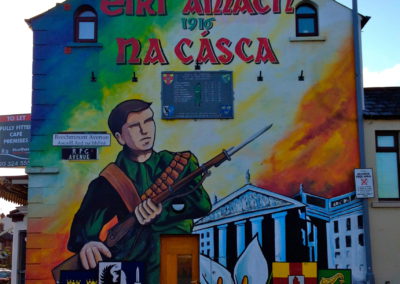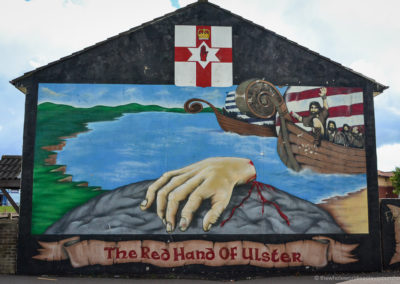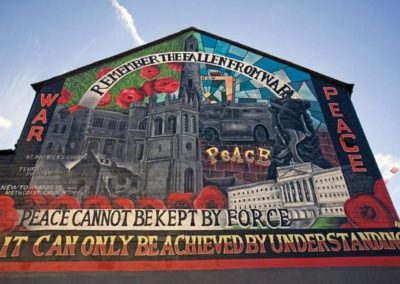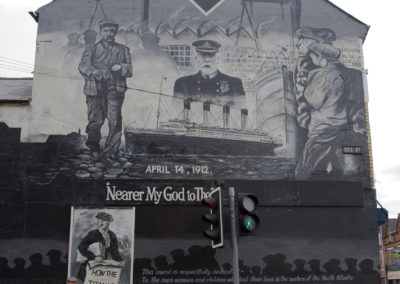North Coast Day Trips
Giant's Causeway
Giant’s Causeway is a cluster of approximately 40,000 basalt columns rising out of the sea on the Antrim Coast of Northern Ireland. These rock formations get their name from an old legend stating that Irish warrior Finn McCool built the path across the sea to face his Scottish rival, Benandonner. There are several variations of the story from this point but each one ends with Finn dressing as a baby and scaring off Benandonner, who thinks the disguised Finn is actually the child of a giant and is too afraid to face his opponent. On his way back to Scotland, Benandonner tears up the path behind him, leaving just what exists today on the Northern Irish coast and the Scottish island of Staffa, which has similar rock formations.
While the legend makes for an interesting story, geologists have a different explanation for the creation of the Giant’s Causeway: volcanic activity. According to them, millions of years ago a volcanic eruption produced a lava flow that cooled quickly from both the top and sides, shaping the lava into hexagonal columns. Now declared a UNESCO World Heritage Site, thousands of tourists visit Giant’s Causeway each year to marvel at and photograph this natural wonder.
Old Bushmills Distillery
Carrickfergus Castle
Dunluce Castle
Dark Hedges
Ballintoy Harbour
Carrick-a-Rede Rope Bridge
Giant's Causeway
Carrick-a-rede Rope Bridge
Ballintoy Harbour
Dunluce Castle
The Dark Hedges
Bushmills Distillery
Game of Thrones Tours
Full day guided bus tour from Belfast visiting filming locations from HBO’s Game of Thrones. We travel around Northern Ireland stopping at key locations sights of this epic drama viewed in over 199 countries around the world . With these tours you have your personal guide and transport to give you 5 star treatment as you visit Kings Landing, Stormlands and Winterfell just to name a few. Explore the ancient Cushendun Caves and discover well-known spots from the series such as the Carrick-a-Rede rope bridge and Dunluce Castle, as well as the UNESCO–listed Giant’s Causeway, which shares the same otherworldly feel as the filming spots.
Tour Highlights
Departing from your location, you’ll head to the location where Ned Stark beheads a member of the Night’s Watch at the beginning of the series, and where Daenerys is captured by the Dothraki in season five. Take a short stop at a location from season six, before heading off to the caves where Red Priestess Melisandre of Asshai gave birth to her murderous shadow assassin. Remember that the night is dark and full of terrors. You can choose from a variety of lunch locations. Your journey continues with a visit to the camp of Renly Baratheon of Storm’s End, and gives you the chance to cross the famous Carrick-a-Rede rope bridge. The next destination is Lordsport, the port town on the island of Pyke, in the Iron Islands, to witness where Theon Greyjoy would return to his family and betray those who raised him. A crucial part of any trip to Northern Ireland is to see the UNESCO–listed Giant’s Causeway. Although it hasn’t been featured in Game of Thrones, the spectacular site is a must see. Visit Dunluce Castle, the 17th century ruins that were used as the exterior of the House of Greyjoy on the show. The journey back to Belfast includes one final stop at the Dark Hedge, with its natural archway of intertwined trees. The road is one of Northern Ireland’s most photographed locations and the place where Arya Stark dressed as a boy to escape from King’s Landing.
Do not book a tour guide. Your chauffeur driver is also an experienced tour guide.
Belfast Peace Wall and Mural Tours
Every city has it’s own unique style, unique shopping but Belfast city has a unique and dark past after emerging from 30 years of conflict.
Northern Ireland has become famous for the murals painted in almost every area of the country. They often depict the history and political views of both traditions and are a way of marking territory. These wall paintings often look intimidating but they have become as much of a tourist attraction as many of the regular attractions within Belfast and beyond.
Our Guides are knowledgable in all aspects of the Northern Ireland conflict and can give you an in-depth information about the murals as you tour them and the peace walls.
The tour includes the main Belfast Peace Wall separating the Loyalist Shankill Road and the Republic Falls Road areas. The wall has been signed by both the Dalai Lama and President Clinton.
Belfast Sightseeing Day Trips
Titanic Belfast
St Anne's Cathedral
Unlike the chief churches of other European cities, St Anne’s Cathedral (often just called Belfast Cathedral) doesn’t have a history stretching back far into the Renaissance or Middle Ages. It was begun in 1899 and, although basically finished in the 1980s, still lacks some finishing touches (like a steeple!)
Queen's University Belfast
Just as Dublin has Trinity, so Belfast has Queen’s. It’s the city’s top university and a center of green and calm. Neo-Gothic and neo-Tudor buildings mingle with less majestic fare. Over 20,000 students attend, so if you come in term-time there’s plenty of people-watching to be done as the campus goes about its business.
It was founded in 1849 and its main building was designed by Charles Lanyon. However, the main pleasure for the visitor is less its history and more just strolling around the grounds enjoying the tranquil enclave and the toney streets surrounding the campus.
Belfast Botanic Gardens & Palm House
Wet and cold? Spend an afternoon in Belfast Botanical Gardens and be transported to a friendlier climate. Established in 1828, the Gardens are probably most famous for their Palm House, which was built soon after. The Palm House, designed by Charles Lanyon, is of gracefully curved steel and glass with a birdcage dome and filled with seasonal displays and, in the ‘stove wing’, a mini-jungle.
The gardens also have a Tropical Ravine – a building with a bridge overlooking tropical varieties like banana, cinammon and orchids – an alpine garden, sculptures and rose beds.
Titanic Quarter
Belfast Castle
Belfast Castle sits high above the city on Cave Hill, looking the very picture of baronial splendor (it’s built in the Scottish Baronial style, like the Queen’s house Balmoral).
There’s been a castle on this site since the 12th century, but this one dates from the 1860s. It was built by the 3rd Marquis of Donegall. It went wildly over budget and, as the Marquis’ fortunes had changed, nearly didn’t get finished at all.
Today it’s a working castle, earning its keep with wedding receptions, conferences, an antique store and an adventure playground. At the visitors center you can find out all about the history of the Castle Hill site.
Noticed a cat motif around the place? It’s all down to a legend that says all will be well with the castle’s residents as long as there is a white cat in situ.
Crown Liquor Saloon
It’s like a museum – where you can drink stout. This 1826 fantasy beguiles the eye with every glance. Look up – there’s a pressed ceiling. There to your left? Brocaded walls and patterned tiles. To the right? Smoked glass screens and stained glass windows. Not to mention gunmetal plates (once used to strike matches) and antique bells (once used to summon your next drink).
Mosaics, carved wooden swans, mirrors, a red granite bar with a heated foot rest – it will spoil you for sodden beer mats and pokies for ever more. This temple to the art of conviviality was actually made by Italian crafstmen who were in Ireland to make Catholic churches. The owner of the Crown convinced them to do some work on the side for him. The result? Somewhere St Peter would be happy to take a tipple.
Stormont Estate and Parliament Buildings
Victoria Square Shopping Centre
Crumlin Road Jail/Gaol
Belfast City Hall
Titanic's Dock and Pump-House
This historical site is the first and last dock of the world famous Titanic. In April of 1912 the massive cruise-liner shored up to set sail from the Belfast port and never returned. Today, visitors can explore the shipyard where this behemoth of a boat came to life. The dry dock and pump-house are perfectly preserved and expert guides unlock a mystical world where engineers built an “unsinkable” ship and the well-to-do embarked on a journey from which they would not return.

Translators Available
We have translators available for speakers of:
- French
- German
- Italian
- Spanish
- Portuguese
- Cantanese
- Mandarin.
Other languages available on request and advanced notice
Get in touch
Contact us now and book your luxury transport









